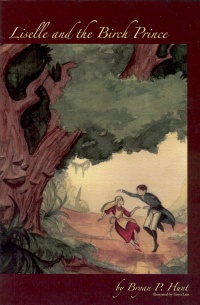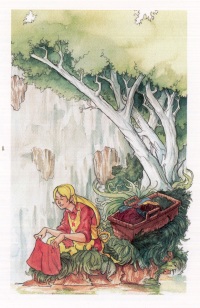| ________________
CM . . . . Volume XVII Number 14. . . .December 3, 2010. 
 |
Liselle and the Birch Prince.
Bryan P. Hunt. Illustrated by Tanya Lam.
Calgary, AB: Corvid Media (www.corvidmedia.com), 2009.
23. pp, stapled, $9.95.
ISBN 978-0-9732072-3-1.
Grades 1-3 / Ages 6-8.
Review by Dave Jenkinson.
**½/4
|
| |
|

excerpt:
A Basketful of Orphan
The doorman did not know what to do. He had heard a “rap, rap, rap” on the door, yet when he opened it all he found was a ratty old basket with a note that said “Liselle”. Inside the blanket was a mess of tattered fabric. And much to his horror, inside the tattered fabric was a very pink and smiling baby.
Jealousy, love and sacrifice are the key ingredients of this brief pourquoi tale which explains the origins of the little black markings found on birch trees and the markings’ meaning. The story takes the form of a bedtime story, but one with a difference as the teller is an old poplar tree who wants two young saplings to stop their rustling, drop their leaves and go to sleep for the winter. In return for his telling them “a story about how the birch got its marks,” the pair agree to shed their foliage and move into a slumber state.
 When a foundling baby is left on the palace’s doorstep, the king decides that the beautiful child, whose name, according to a note left with her, is Liselle, will be allowed to live in the castle since “we can always use another washer girl.” There was only one dissenting voice, that of the small prince, who says, “Make her go away!” as he is jealous of the attention Liselle is receiving from everyone. When a foundling baby is left on the palace’s doorstep, the king decides that the beautiful child, whose name, according to a note left with her, is Liselle, will be allowed to live in the castle since “we can always use another washer girl.” There was only one dissenting voice, that of the small prince, who says, “Make her go away!” as he is jealous of the attention Liselle is receiving from everyone.
As soon as Liselle is old enough, she is set to work helping in the kitchen and the stables as well as doing the wash. Even though Liselle is just a servant in the king’s court, the prince’s jealousy of her continues, and he mistreats her whenever he can, “[b]ut Liselle was not upset by any of this. She went about her days singing and doing her chores. This angered the prince even more.”
When Liselle grows into a beautiful young maiden, she is adored by everyone but the prince who sets her the arduous task of taking his clothes some distance to be washed in the cold waters of the pool on Cold Creek and then dried on the rocks. When Liselle returns to the palace with the prince’s clean wash, she hides her smile and tells him that completing this task “was horrible.” An elated prince increases the size of her loads on the following days, until one day when the load is so large that she cannot complete the wash and still return to the castle before dark, she is forced to remain overnight in the forest by the pool.
As the sun sets, the trees become transformed into people whose magnificent clothes are constructed of leaves and moss. A handsome birch prince appears and asks Liselle to dance, referring to her as Princess. When she says she is not royalty, he responds, “I fear you are mistaken, Lady....For a princess is not made by a royal family, but by her bravery and the goodness of her heart.” The two dance the night away, and when the castle’s prince sees Liselle not returning until the next morning, he is delighted that he has worked her so hard that she’s had to spend an uncomfortable night sleeping in the forest.
The daily/nightly washing/dancing pattern continues until one evening when the faerie queen joins the dancing group. The birch prince warns Liselle never to enter the doorway to the faerie queen’s cave as “[i]t is death for any mortal that enters.” Unfortunately, the next morning Liselle forgets to look dispirited as she returns to the castle, and the jealous prince sees her dancing and singing as she enters the palace.
That day, the evil prince stealthily follows Liselle, sees what happens at dusk and confronts the birch prince. The nasty prince’s sword is no match for the birch prince’s birch whip, and the evil prince runs away. When Liselle returns to the castle the following day, she is met by the prince and a group of men, all armed with axes. The prince demands that she lead them to the forest so that all the trees can be cut down, but Liselle, instead, takes them through the doorway of the faerie queen’s cave, “and one by one they died..”
The story does not end there, however. “It is said that the faerie queen took pity on Liselle and let her live on as a butterfly, but nobody knows for sure.” As for the birch prince, “before this the birch had pure white bark, and now all birches are covered in little markings, the language of the birch. These markings say, ‘Liselle, my princess., I miss you. Liselle my love come back.’”
Liselle and the Birch Prince is a nice tight, engaging little story with excellent illustrations by Tanya Lamb. The book’s principal shortcoming is its format which will be off-putting to its young listening/reading audience. Each of the book’s eight sets of facing pages is a named chapter, and, with two exceptions, the text is printed on one page in two columns and in a very small font. The amount of text on each page is simply too much for the picture book format
The remaining facing page of each pair consists of a full-page illustration by Lam who also supplies a smaller illustration for the text pages. In two instances, the “time” sequence of the illustrations in a chapter is reversed, a situation which could confuse a prereading child who is trying to “read” the story by means of just the illustrations.
Recommended.
Dave Jenkinson, CM’s editor, lives in Winnipeg, MB.

To comment on this title or this review, send mail to
cm@umanitoba.ca.
Copyright © the Manitoba Library Association. Reproduction for personal use is permitted only if this copyright notice is maintained. Any other reproduction is prohibited without permission.
NEXT REVIEW |
TABLE OF CONTENTS FOR THIS ISSUE- December 3, 2010.
AUTHORS |
TITLES |
MEDIA REVIEWS |
PROFILES |
BACK ISSUES |
SEARCH |
CMARCHIVE |
HOME |

 When a foundling baby is left on the palace’s doorstep, the king decides that the beautiful child, whose name, according to a note left with her, is Liselle, will be allowed to live in the castle since “we can always use another washer girl.” There was only one dissenting voice, that of the small prince, who says, “Make her go away!” as he is jealous of the attention Liselle is receiving from everyone.
When a foundling baby is left on the palace’s doorstep, the king decides that the beautiful child, whose name, according to a note left with her, is Liselle, will be allowed to live in the castle since “we can always use another washer girl.” There was only one dissenting voice, that of the small prince, who says, “Make her go away!” as he is jealous of the attention Liselle is receiving from everyone.